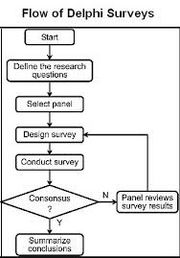The Delphi Technique in Project Management
Marcoronzoni (Talk | contribs) |
Marcoronzoni (Talk | contribs) |
||
| Line 12: | Line 12: | ||
[[File:delphi2.png|thumb|caption]] | [[File:delphi2.png|thumb|caption]] | ||
This method can be reiterate many times based on the analysis and the ranking of different factors list on panels, controlling every time the feedbacks (it can be done also online with virtual teams). It is used also to identify risk and opportunities, learning from mistakes, promoting a brainstorming session or to create a Work Breakdown Structure. | This method can be reiterate many times based on the analysis and the ranking of different factors list on panels, controlling every time the feedbacks (it can be done also online with virtual teams). It is used also to identify risk and opportunities, learning from mistakes, promoting a brainstorming session or to create a Work Breakdown Structure. | ||
| − | ==Brief history introduction== | + | |
| + | |||
| + | ==Big Idea== | ||
| + | ===Brief history introduction=== | ||
Delphi method was developed in 1953 by Olaf Helmer and Norman Dalkey of the Rand Corporation as an instrument to forecast the impact of technology on warfare. | Delphi method was developed in 1953 by Olaf Helmer and Norman Dalkey of the Rand Corporation as an instrument to forecast the impact of technology on warfare. | ||
The name refers to the Delphi Oracle, a priestess at the Apollo temple in ancient Greece. | The name refers to the Delphi Oracle, a priestess at the Apollo temple in ancient Greece. | ||
| − | |||
| − | |||
[[File:delphi3.jpg|thumb|caption]] | [[File:delphi3.jpg|thumb|caption]] | ||
[[File:delphi.png|thumb|caption]] | [[File:delphi.png|thumb|caption]] | ||
Revision as of 10:22, 14 September 2016
Contents |
Abstract
According to the definition of ISO 21500:2012 a Project is: “a unique set of processes consisting of coordinated and controlled activities with start and end dates, performed to achieve project objectives. Achievement of the project objectives requires the provision of deliverables conforming to specific requirements”.[1] [2]
The Delphi technique is used mostly for reaching consensus among experts, regarding the decision making process. Moreover, as a project manager is crucial to think about the impact that possible future events can have on your projects, this technique helps also in forecasting the future with some grade of certainty, estimating likelihood and outcomes.
The iterative process consist of anonymous exchange of views, assumptions and prevision given to a facilitator that will write a conclusive report. The group will read the report of the previous meeting, update their discussion and thoughts for the new report. The process continue in this way until the consensus is reached among all the participants. The anonymity assure the free expression of opinion and encourage openness. The process will start from a broad perspective than in the end will scope the core problems and questions to assure consensus, 3 phases has to be followed:
- Brainstorming: experts list the relevant factors and remove the duplicates
- Narrowing down: differentiate in panels and factors selection
- Ranking: rank the factors on own panel, calculate average, assess consensus
This method can be reiterate many times based on the analysis and the ranking of different factors list on panels, controlling every time the feedbacks (it can be done also online with virtual teams). It is used also to identify risk and opportunities, learning from mistakes, promoting a brainstorming session or to create a Work Breakdown Structure.
Big Idea
Brief history introduction
Delphi method was developed in 1953 by Olaf Helmer and Norman Dalkey of the Rand Corporation as an instrument to forecast the impact of technology on warfare. The name refers to the Delphi Oracle, a priestess at the Apollo temple in ancient Greece.
Applications
(Add Applications)
Limitations
(Add Limitations)


